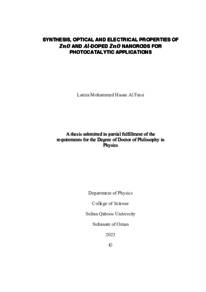Document
Synthesis, optical and electrical properties of of ZnO and Al doped ZnO nanorods for photocatalytic applications.
Other titles
تصنيع ودراسة آلية النمو والخصائص الفيزيائية للأعمدة النانونية لأكسيد الزنك المشوب بالألمنيوم لتطبيقات التحفيز الضوئي
Publisher
Sultan Qaboos University.
Gregorian
2023
Language
English
English abstract
Controlling the structural and physical properties of ZnO nanorod (NR) arrays is of
great interest for their integration into optoelectronic devices and their efficient use as
photocatalysts for the water treatment applications. Extrinsic doping of these
nanomaterials is challenging since it may result in a poorly aligned array or cause
irreversible morphological changes. In this work, ZnO and Al-doped ZnO (AZO) NR
arrays are grown by a bottom-up chemical route using a microwave-assisted
hydrothermal method. Two seed layers are considered 1) thin ZnO film grown by spray
pyrolysis and 2) conductive AZO layer grown by magnetron sputtering. The samples
are characterized with various techniques to probe their morphology, crystal structure,
surface chemistry, optical/electrical properties, and photocatalytic performance. The
growth parameters (quality of seed layer, precursor sol. concentration, alkaline agent,
and pH) are optimized to achieve a high-quality and vertically aligned NR arrays.
Thermodynamic simulations are carried out to understand the combined effect of the
pH and Al doping. A mechanistic model is proposed based on supersaturation and
electrostatic interactions between charged species in solution and charged crystalline
planes of ZnO NRs. Moreover, XRD, TEM, and XPS analyses of the samples have
shown an excellent Al doping efficiency of ZnO using this chemical route. The best
ZnO and AZO samples are used as photocatalysts to degrade methylene blue under
visible light irradiation. To understand the results, the samples are further
characterized for their surface chemistry and optical properties (Absorption and
photoluminescence). The results show that doping enhances visible light absorption
which leads to high photocatalytic performance. Moreover, the combined effect of
alkaline pH and Al doping seem to favor non-radiative transitions from CB to deep level states (Zni defects). The defect levels act as trapping centers inhibiting
recombination and enhancing the photocatalytic performance. For their integration
into optoelectronic devices, well-aligned ZnO and AZO arrays are successfully grown
on a conductive seed layer. The electrical impedance measurements and the Mott Schottky approach are used to quantify the carrier concentration of the samples.
Extremely high doping of 1020- 1021/cm3 is achieved under 1% Al doping confirming
that the samples behave as a non-degenerate semiconductor. This finding is used to
explain the variation of the optical bandgap with Al doping. In the last part of the
thesis, a numerical/theoretical framework is initiated and used to investigate Al doping
mechanism through Atomistic Simulations using GULP. The results show that the
most plausible doping scenario is Al substituting Zn atoms. However, the doping
process induces the formation of some intrinsic point defects namely vacancies of Zn
and oxygen interstitials that act as dopants compensation.
Member of
Resource URL
Category
Theses and Dissertations

